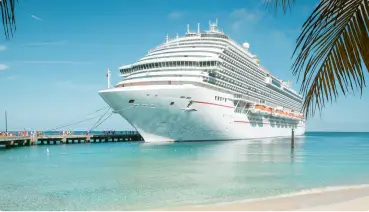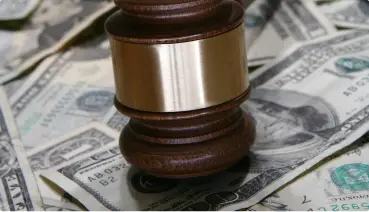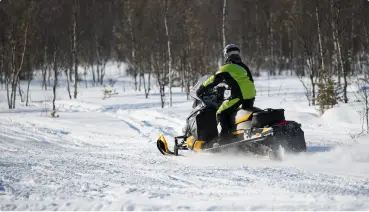If you don’t live in one of the cities that are most often targeted by these tropical storms, you may not be familiar with the destruction they can cause. Every year, the Congressional Budget Office (CBO) estimates that hurricane damage equates to an average $28 billion, with the vast majority affecting Florida, Texas, and Louisiana. Without the proper insurance or coverage, that damage can become an insurmountable burden for those in the path of these dangerous storms.
Beyond the wind, rain, and potential for damage to your home or property, have you ever wondered about the emotional toll of living through a hurricane? We surveyed over 1,200 people who’d personally experienced at least one hurricane in their life to understand just how stressful these storms can be, how much they really spend to prepare, and what they do to pass the time during the storm.
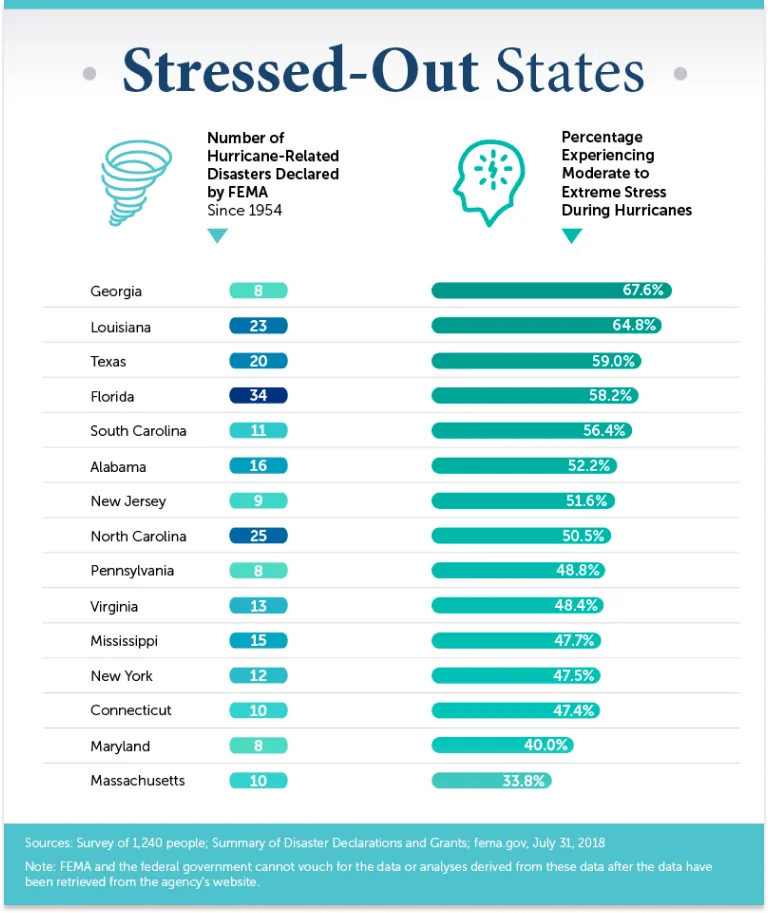
High Winds Equal High Blood Pressure
When it comes to natural disasters, the physical damage they cause may seem obvious. Pictures of homes with their roofs caved in or streets flooded so badly that you have to use a boat to get around will typically make national news. But what you may not see on TV is the emotional damage storms like these can cause, and the long-lasting impact of these traumas.
Where you live and how often you experience this kind of storm can have a major impact on how you respond to them emotionally. In Georgia, there have only been 8 disasters declared by FEMA since 1954 that were a result of hurricanes. More than 2 in 3 people who’d experienced a storm in that state reported feeling moderate to extreme levels of stress as a hurricane approached. Without knowing exactly how severe the a storm will be, preparations may include everything from boarding up your home, filling up on gas, and grocery shopping for necessities to carry you through days or weeks without power.
People in Louisiana, Florida, and Texas experienced far more storms during the same timeframe, and only reported being slightly less stressed when they knew a hurricane was coming. Because most people know that these storms can be catastrophic or even deadly, even those from states with very few instances of hurricane activity reported feeling moderate to extreme levels of stress.
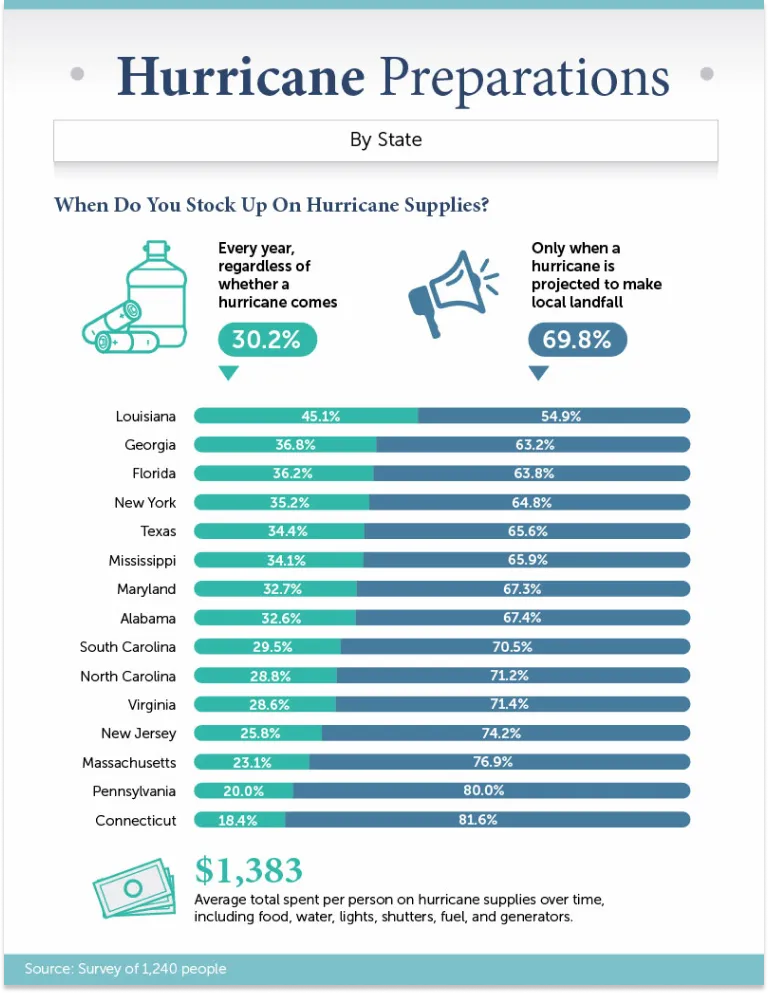
Stocking Up for a Windy Day
In some states, you’re safe from being taken advantage of when it comes to stocking up before a hurricane. Price-gouging laws make it illegal in states like Florida for retailers to raise the cost of basic goods and services beyond a certain threshold. Of course, that doesn’t mean you’ll actually be able to find those products on the shelves, especially if your neighbors have beaten you to the punch.
If you’ve ever experienced the mad dash to the grocery store for food and supplies before a storm, you likely understand why so many people choose to prepare well in advance (regardless of whether a storm is actually coming or not). In Louisiana, more than 45 percent of people who experienced a hurricane chose to stock up on supplies annually rather than waiting for a storm to take form. This attitude could be due to memories of Hurricane Katrina. In August 2005, more than 1,800 people lost their life as a result of this infamous storm, which made landfall in Grand Isle, Louisiana.
More than 1 in 3 people from Georgia, Florida, New York, Texas, and Mississippi – among others – had the same idea. Generally, though, nearly 70 percent of people who had firsthand experience with hurricanes chose to wait until a storm was projected to make landfall before purchasing supplies – which typically cost our respondents a lifetime total over $1,380 on average.
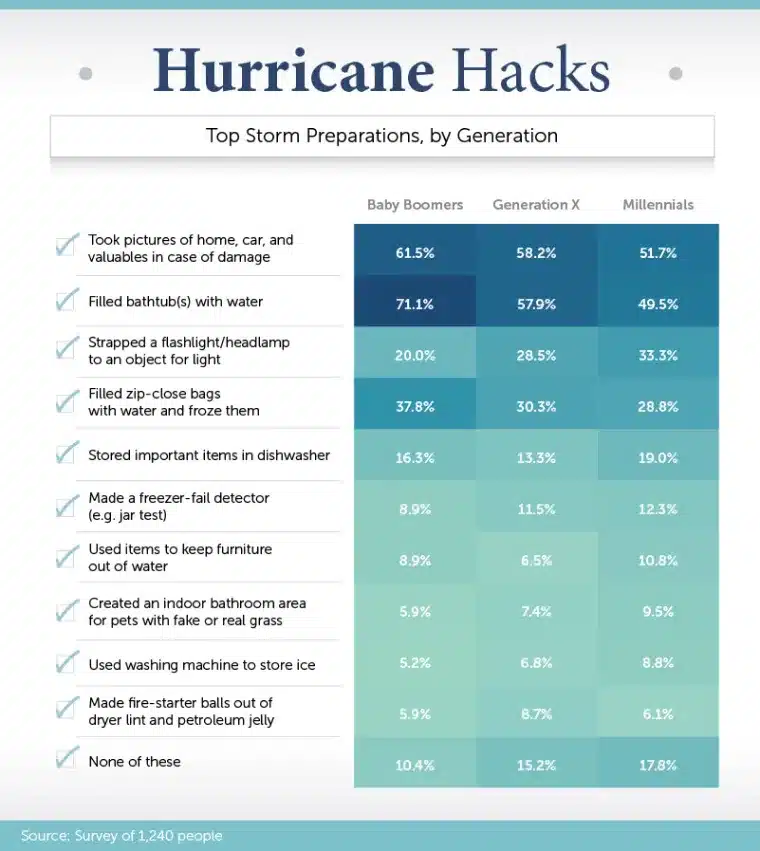
Generational Preparation Preferences
When resources are scarce or access to water or electricity is limited, we’re sometimes forced to get a bit creative and find new uses for everyday objects. Overall, we found that there were several differences between how each generation went about their improvisation.
One such hack involved one of the most essential elements of survival: water. Over 71 percent of baby boomers said they prepared for a hurricane by filling the bathtub with water, compared to only 57.9 percent of Gen Xers and 49.5 percent of millennials.
Baby boomers were also more likely to take pictures of their most valuable possessions in case of damage than the other two groups. Meanwhile, just over 33 percent of millennials said they strapped a flashlight to an object to make a lamp, compared to only 28.5 percent of Gen Xers and 20 percent of baby boomers.
In fact, millennials led the way with a couple of preparation techniques, and were most likely to creatively use household appliances during storms.
For example, do you store important items in the dishwasher during a hurricane? About 19 percent of millennials reported that they did exactly that. They also used their washing machines as a makeshift freezer to store ice, at 8.8 percent. Only 5.2 percent of baby boomers did the same.
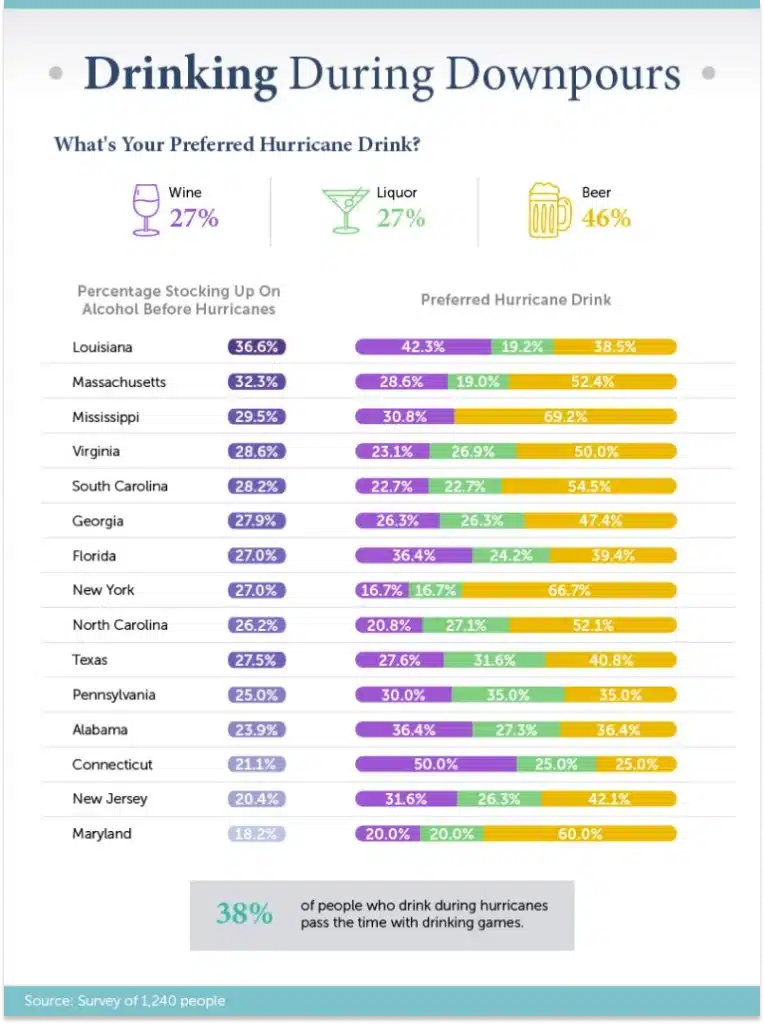
Drinking Through the Storm
It’s a heavy hitter, and they don’t call it a Hurricane for nothing. In this case, we’re talking about the cocktail.
The iconic rum-infused drink made popular in New Orleans isn’t named for the storm, but the shape of the glass in which it is served. However, that doesn’t mean that people experiencing an actual hurricane don’t want something sweet to soothe their nerves.
In fact, more than 36 percent of people who’d been through a hurricane in Louisiana included alcohol on their storm prep grocery lists. For 42.3% of those people, their preferred hurricane beverage was wine.
Louisiana wasn’t alone in this habit. Our survey revealed that roughly 30 percent of people from Massachusetts and Mississippi partook in hurricane drinking as well, although they tended to favor beer over wine or liquor. Plus, since nine other states were within six percentage points of Mississippi, there were many others who sought solace from the storm with an adult beverage.
Overwhelmingly, the go-to choice for alcohol during a storm was beer (among the 45.6 percent of people who drink during a hurricane), and another 27 percent opted for wine or liquor respectively. What’s more, 38% of those imbibing during hurricanes reported doing so in conjunction with drinking games.
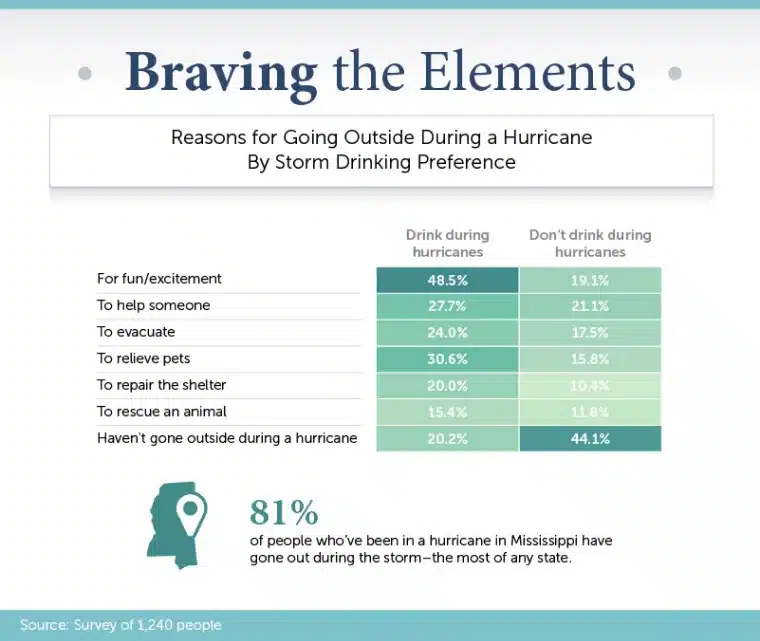
Bravery in a Bottle
For most people, the primary objective during a hurricane is to stay safe and keep their family out of harm’s way. If you’ve never been through one of these tropical storms before, that can certainly seem like a daunting task in the days and hours leading up to the hurricane’s impact. Ensuring that you have a disaster kit and understand the evacuation routes can prove essential for feeling prepared when the time comes.
There are many different ways to practice safety during a storm, but many would agree that there’s one thing you should never do when a hurricane hits: go outside.
Of course, that doesn’t mean some people won’t try, especially if they’ve been emboldened by a bit of liquid courage. Nearly half of people who drank during hurricanes said they went outside during the storm for fun and excitement.
Only 19.1 percent of people who didn’t drink during these storms said the same. For others, going outside was sometimes a matter of evacuation or rescue, though those rates were still higher among people who had been drinking versus those who refrained. In Mississippi, more than 4 in 5 people who experienced any type of hurricane admitted that they’d gone outside during a storm at least once.

How the Sexes Weather a Storm
If staying safe and dry is one of your priorities during a hurricane, there’s often little else to do except stay inside and wait for the storm to pass. Of course, you could catch up on work or your favorite TV show, but if electricity is cut off, you might have to get creative to pass the time.
So how did our participants choose to weather the storms in their areas? More than 83 percent of women and 76 percent of men took time to read a book. You may not feel like you have the time to read on a daily basis, but without electricity to watch TV or browse the internet, reading can be a welcome distraction for people experiencing a traumatic storm.
Following reading, women preferred to have deep conversations, nap, and do puzzles or word games. On the flip side, men opted to listen to music (54.9 percent), have deep conversations (47.6 percent), and nap (41.6 percent).
And what about getting intimate? Men led the way in that category, with 35.6 percent reporting that having sex was one of their favorite ways to pass the time, compared to 23.4 percent of women.
Respondents also said that 5.6 days was the longest time they had gone without power due to a hurricane.
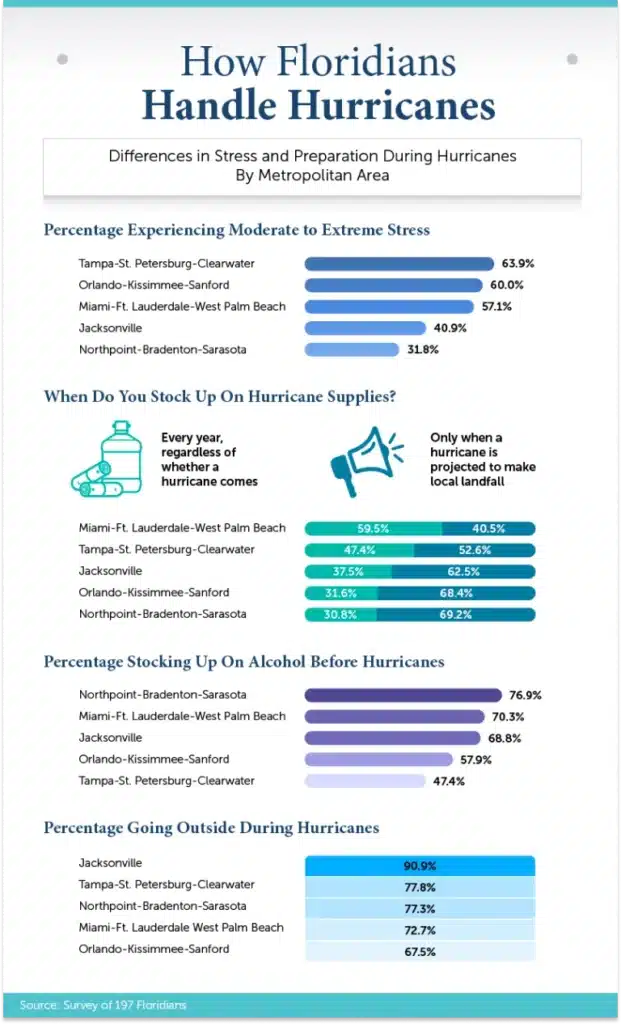
How the Sunshine State Compares
Florida is a large and diverse state, but it wouldn't be a stretch to assume that every citizen there has some hurricane-related experience.
Those who’ve weathered a storm in the Tampa-St. Petersburg-Clearwater area, along the Western Gulf Coast, were most likely to experience the highest degree of stress according to our survey. Behind them were residents around the mid-state area surrounding Orlando, at 60 percent.
Those in the Miami area were most likely to stock up on hurricane supplies annually. Although this year’s forecast for hurricanes looks safer than last year, these residents were less likely to wait until the last minute to gather essential goods. As they do in Miami, we encourage you to prepare for potential emergency situations by stocking up on supplies in advance, so you and your family can be as safe as possible with less stress.
Only 30.8 percent of Northpoint-Bradenton-Sarasota residents said they made annual storm preparations. However, those same residents did lead in another category, with over 76.9 percent reporting that they stocked up on alcohol before a hurricane.
Interestingly, the area with the most stress (Tampa-St. Petersburg-Clearwater) was the area least likely to stock up on alcoholic beverages.
Braving the Storm
If you live in an area along the coast that could be affected by a hurricane, you likely already know the drill. During hurricane season, you might end up watching a tropical depression turn into a named storm and start heading for land. Even after you prepare your home and your family for the worst, sometimes you end up with a few days off from work to read, have deep conversations, or take naps.
But that isn’t always the case. In the blink of an eye, a seemingly gentle storm can turn deadly, and if you aren’t prepared, the consequences can be severe. Storm surges, flooding, winds, and rip currents can be dangerous encounters, and that makes following the proper safety protocols more important than ever.
The situation may be stressful in the moment, but taking these storms seriously is one of the most important ways to make sure you and your family stay safe.
We encourage everyone to make a list of necessary items and pick them up ahead of time. Go over emergency preparations with your family – or those you live and work with – to make sure that everyone knows where safe areas and exits are located.
This information from the American Red Cross may be helpful.
Methodology
Using Amazon’s Mechanical Turk service, we surveyed 1,240 people who’d experienced at least one hurricane in their lifetime. 49.6% were men, 49.9% were women, and fewer than 1% were non-binary. Participants ranged in age from 18 to 82 with a mean of 36.6 and a standard deviation of 11.9. They were asked to select which states they’d been in during a hurricane and states with fewer than 26 respondents were not shown in the visualizations of our findings.
We also used data from the Federal Emergency Management Agency (FEMA) to show the number of county-level hurricane-related disasters that impacted states from 2000 through 2016. These data were from the Summary of Disaster Declarations and Grants, which we accessed on July 31, 2018. “FEMA and the federal government cannot vouch for the data or analyses derived from these data after the data have been retrieved from the agency’s website.”
Limitations
The data above was self-reported. There are many issues with self-reported data, such as: selective memory, telescoping, attribution, and amplification.
No statistical testing was conducted, so all claims are based on means alone. As such, this content is purely investigational, and future research should approach this topic in a thorough manner.
The sample size for Jacksonville, FL was 22, and the sample size for Northpoint-Bradenton-Sarasota, FL was 22. It is possible that with more participants from these metropolitan areas we could have gained more insight into the population.
Sources
- https://www.fema.gov/about/reports-and-data/openfema
- https://www.nationalgeographic.com/environment/article/hurricanes-typhoons-cyclones
- https://www.scientificamerican.com/article/the-trauma-after-the-storm/
- https://abcnews.go.com/US/hurricanes-harvey-irma-cost-us-economy-290-billion/story?id=49761970
- https://www.forbes.com/sites/adammillsap/2017/09/07/price-gouging-laws-not-hurricanes-empty-stores-shelves/#44f2fcd750ce
- https://www.cnn.com/2013/08/23/us/hurricane-katrina-statistics-fast-facts/index.html
- http://www.patobriens.com/patobriens/havefun/our_story.asp
- https://www.collegeranker.com/best-drinking-games/
- https://www.sun-sentinel.com/2017/09/04/hurricane-irma-prep-five-things-you-need-to-buy-at-the-grocery-store-now/
- https://www.redcross.org/get-help/how-to-prepare-for-emergencies/types-of-emergencies/hurricane.html
- https://www.miamiherald.com/news/weather/hurricane/article216362790.html



